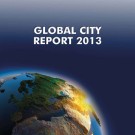
The Global City Report 2013* presentation, developed by Scenari Immobiliari and Generali Immobiliare Italia ,offered visions, that show much more than quantitative data about changes and competitiveness between cities.
The formula for a sustainable development? “We can change the city by using less concrete and more infrastructural technology.”
“The city reaches as far as the Net, where the terminals of infrastructures get to and meet” said prof Mario Deaglio (Centro Ricerca e Documentazione Luigi Einaudi). Mario Breglia (Scenari Immobiliari) stressed the importance of the benchmark “attractiveness of the cities” not foreign investors only, but Talents from all sectors also attracted by the Culture and New Ways of Knowledge.
Prof Deaglio agrees on that and shows three kinds of attractiveness to revitalize the Italian cities: “from the bottom” (immigrants from countries where there is no work for them), “from the top” (educated immigrants attracted by the new frontiers of Knowledge) and the value of Made in Italy and Italian lifestyle.
The survey presented by Alessandro Balducci (Politecnico di Milano) shows a new vision of city; the “Mega-City-Region” is no longer based on the centre hierarchical concept , but on the size of the Net. City Nets, developing in in-between areas.
Carlo Ratti (MIT Senseable City Lab) talks about Shared Economy and finds the key to improving the quality of life in transports, the Net, technological infrastructures and in a possible sharing of data (with presentation of in progress projects in Singapore and NY City) Carlo Ratti closes “We can change the city by using less concrete and more infrastructural technology.”
Editorial by Renata Sias, editor of WOW! Webmagazine
*The 2013 GC Report, studying the economic and territorial changes in twenty European cities, show that London and Paris are still at the top, while Milan ranks first for the progress made in the field of Culture. At the bottom, Lisbon and Athens.

















